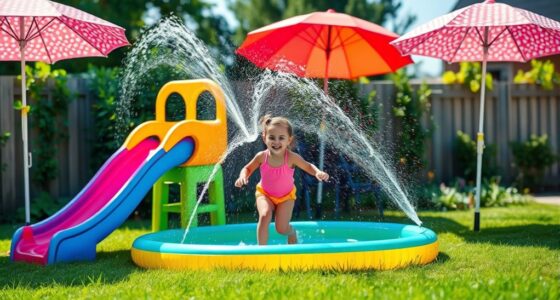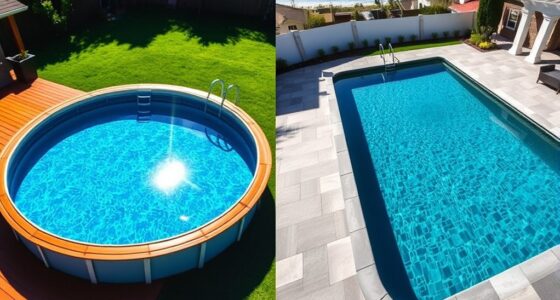To winterize your home pool properly, first test and adjust the water chemistry to recommended levels. Remove debris and clean the pool thoroughly. Drain and winterize your equipment, then lower the water level appropriately for your cover type. Install and secure your winter cover, ensuring it’s tight and protected from wind. In colder climates, take extra steps like draining lines and adding antifreeze. For more tips, explore the complete checklist to guarantee your pool survives winter unscratched.
Key Takeaways
- Test and adjust water chemistry to recommended levels before winterizing, and remove debris from the pool surface and floor.
- Drain plumbing lines, remove drain plugs, and store equipment in a dry, non-freezing location.
- Lower water level appropriately, install and secure the pool cover, ensuring it is flush and overlapped correctly.
- Secure the cover with straps, springs, and weights, and manage air bubbles and water levels to prevent damage.
- Conduct a spring inspection, clean debris, check for damage, and prepare equipment for the pool opening.
Test and Adjust Water Chemistry

Have you tested your pool water recently? Regular testing is essential to keep your water balanced, especially before winterizing. Start by running your pump and filtration system for at least an hour to ensure proper mixing. Collect water samples from about 12-18 inches below the surface, avoiding returns and chemical dispensers. Follow the correct testing order: check alkalinity first, then pH, calcium hardness, cyanuric acid, and finally chlorine or bromine levels. Use quality tools like test strips, liquid kits, or digital testers for accurate results. Adjust each parameter to the recommended ranges: alkalinity 80-120 ppm, pH 7.2-7.8, calcium hardness 200-400 ppm, cyanuric acid 30-50 ppm, and sanitizer 1-3 ppm. Consistent testing helps prevent problems during winter and ensures your pool stays healthy. Incorporating a proper testing procedure can improve the accuracy of your results and lead to better water chemistry management.
Remove Debris and Clean the Pool

Before closing your pool, you need to remove surface debris with a skimmer net and clear out any large debris that could clog the filter. Next, vacuum the entire pool floor and walls thoroughly to eliminate dirt and prevent stains over winter. Proper filter maintenance can enhance the overall cleanliness and efficiency of your pool system, ensuring it functions properly when reopened. Finally, clean all equipment components like skimmer baskets and filters to make sure everything is ready for storage. Regular cleaning during the off-season helps maintain water clarity and prevents buildup that could cause problems during reopening.
Skim and Net Debris
Regularly skimming your pool is essential for keeping the water clear and preventing debris from sinking to the bottom. Use a manual skimmer net attached to a pole, or built-in or above-ground skimmers, to remove floating leaves, insects, and other debris. Work in a systematic pattern to guarantee thorough coverage. Inspect and clean the skimmer net frequently, rinsing it with fresh water and mild soap to remove chemicals and debris. Shake off stubborn debris and store the net properly to extend its lifespan. Regular skimming improves water clarity, reduces chemical use, and lessens strain on your filtration system. Additionally, maintaining a clean pool surface can help minimize noise levels of modern heat pumps that may be used for pool heating during winter. Keeps debris from sinking not only assures a healthier swimming environment but also makes your winterization process smoother. Staying diligent now saves time during spring reopening.
Vacuum Thoroughly
Vacuuming your pool thoroughly is a crucial step in winterizing because it removes remaining organic debris, algae, and dirt that can cause staining or promote algae growth during the off-season. Use a manual vacuum attached to a telescopic pole for precise control, focusing on corners, steps, and ledges where debris tends to settle. Vacuum slowly and methodically, ensuring no dirt is left behind. Running the pump while vacuuming helps push debris to the filter, keeping the pool cleaner. Before starting, skim the surface to remove floating debris, and ensure water chemistry is balanced. Regularly clean or replace vacuum bags and filter cartridges to maintain suction. After finishing, backwash the filter and disconnect equipment for storage. Proper vacuuming prevents long-term damage and simplifies spring cleaning. Additionally, incorporating tuning options can improve the pool equipment’s performance and efficiency, ensuring your pool functions optimally during winter months.
Clean Equipment Components
Removing debris from your pool equipment is essential for maintaining proper water flow and preventing clogs during winter. Start by skimming leaves, twigs, and debris from skimmer baskets and pump strainers. Rinse filter grids or cartridges with a hose to improve filtration. Regularly inspect and empty pump baskets to reduce strain on the motor. Clear debris from drains and inlet fittings to ensure smooth circulation and prevent damage. Detach and clean removable parts like valves and strainers before draining and storing equipment. Thoroughly backwash sand or DE filters, and rinse cartridge filters with a cleaner. Remove pump and filter plugs to drain residual water, and use compressed air or a blower to clear lines. Wipe down equipment surfaces to prevent corrosion, ensuring everything is clean and dry for winter storage. Proper maintenance of pool equipment also extends filter lifespan and ensures readiness for summer use.
Drain and Winterize Pool Equipment

Before winter arrives, you need to drain and winterize your pool equipment to prevent damage from freezing temperatures. Start by turning off the main power supply to ensure safety. Remove drain plugs from the pump strainer basket housing, pump volute, filter tank, and other equipment. Position the multiport valve handle between settings or use the “Winter” setting if available. Disconnect filter hoses from skimmer and return fittings for above-ground pools, then move the equipment to a non-freezing location. Store all removed parts in a dry, non-freezing area. Drain plumbing lines completely, then insert winterizing plugs into return and skimmer lines. Add non-toxic pool antifreeze to lines for extra protection. Properly draining and winterizing your equipment can help prevent costly repairs caused by trapped water and freezing damage. Ensuring your pool accessories and covers are secure and properly stored helps prevent freezing damage and ensures a smooth start-up in spring.
Lower the Water Level Appropriately

Lowering the water level is a crucial step in winterizing your pool because it helps prevent freezing damage while ensuring the pool remains structurally sound. You should lower the water to 4-6 inches below the skimmer for solid covers, or 12-18 inches for mesh covers. Never drain the pool completely, as this can cause structural damage. For inground pools, aim for about 1 inch below the skimmer, while above-ground pools may need different adjustments based on cover type. Be cautious not to expose equipment to freezing temperatures. Proper water level management also supports effective chemical distribution and reduces algae growth. Regularly check the water level throughout winter, adjusting as needed to prevent damage and maintain pool integrity. Monitoring the water level is essential to ensure that it stays within safe limits and prevents any potential issues caused by fluctuating temperatures. Maintaining an appropriate water level can also help in preventing freeze-related damage by allowing the pool cover to function properly.
Install and Secure the Winter Cover

Choosing the right cover type guarantees your pool stays protected throughout winter. Once you’ve laid the cover, make sure to secure the edges tightly to prevent wind from lifting it. Finally, check for and remove any air bubbles to keep the cover flush against the water’s surface. Proper installation is essential to ensure the cover functions effectively and maintains your pool’s condition during the off-season. Additionally, selecting a cover with odor control features can help minimize unpleasant smells during storage.
Choose Proper Cover Type
Selecting the right winter cover is essential for protecting your pool throughout the cold months. Your choice depends on your climate, budget, and maintenance preferences. Tarp covers are cost-effective and simple but less durable, requiring water bags or cables for secure anchoring. Mesh security covers are lightweight, easy to install, and allow rain and snow to pass through, reducing pooling. They also block UV rays, helping prevent algae growth. Solid security covers offer maximum protection, blocking debris, sunlight, and evaporation, making them ideal for harsh winters but are heavier and more expensive. Each cover type serves different needs based on safety, durability, and convenience. Consider your local climate and how much debris or snow your pool typically receives. Additionally, understanding electric power generation with bike generators can provide alternative energy solutions for equipment maintenance during the off-season. Choosing the right cover type ensures your pool stays clean and protected until spring.
Secure Edges Tightly
To effectively secure your winter cover, start by unrolling it evenly over the pool, ensuring the protective side faces downward. Make sure the cover overlaps the edges by at least 20 inches to allow for proper anchoring. Center the cover so it drapes vertically on the pool walls, resting on the water’s surface, not suspended above it. Use buckets of water or weights around the perimeter to hold it in place temporarily. Mark anchor points on the deck with chalk, then drill holes at the recommended depth. Insert anchors and attach straps, springs, and cables through the grommets to provide tension. Tighten everything evenly with a winch or hand crank, ensuring no slack or over-tightening. Confirm the edges are secure, with no gaps for wind or debris to enter. Regularly inspecting the tension helps maintain the proper fit throughout the winter season.
Remove Air Bubbles
Before securing your winter cover, it’s important to remove any air bubbles trapped beneath it. Air pockets can cause uneven pressure, damaging the liner or cover over time. To prevent this, gently smooth the water surface to release trapped air before laying the cover. Use a wave or sweeping motion as you unfold the cover, helping air escape and preventing foldovers. Consider adding an air pillow inflated about 50-75% and centered in the pool; this absorbs expansion and reduces bubbles. Ensure the water level is just below the skimmer to minimize air pockets. When placing the cover, spread it evenly without folds or wrinkles, and check for visible air bubbles. Securing the cover tightly with water bags or weighted tubes will help maintain pressure and prevent air entrapment underneath. Additionally, understanding the influence of technology on artistic expression can inspire creative ways to enhance your pool area with decorative covers or lighting options.
Implement Climate-Specific Winterizing Measures

Implementing climate-specific winterizing measures guarantees your pool stays protected throughout the colder months. For mild climates, start winterizing when temperatures drop below 65°F, and maintain proper water chemistry with pH between 7.0–7.4 and chlorine around 2.0 ppm. Use a cover to retain heat and prevent surface freezing, but regularly check water chemistry for effectiveness. In moderate climates, drain external plumbing lines, blow out water from pipes, and use winterizing chemicals to keep water quality stable. Proper water circulation during winter months helps prevent stagnant water and algae buildup. For extreme cold regions, drain all equipment, disable solar panels, and add antifreeze to prevent freeze damage. Each climate requires tailored actions to ensure your pool remains in good shape during winter, avoiding costly repairs or damage. Monitoring water levels and chemical balance throughout the season is also essential to prevent issues like algae growth or corrosion.
Final Inspection and Preparations for Spring

After completing the winterizing process, it’s important to give your pool a thorough inspection and prepare it for spring opening. Start by checking the pool cover for tears, debris, or signs of damage, and clean it thoroughly. Make certain all water tubes, plugs, and skimmer gizmos are in place and in good condition. Remove any remaining debris from the water and surface, and inspect the pool’s interior for stains or algae growth. Test the water quality and chemical balance, aiming for a pH of 7.2-7.6, alkalinity of 80-120 ppm, and calcium hardness of 200-400 ppm. Circulate the water well before opening to distribute chemicals evenly. Additionally, properly winterized pools tend to require fewer chemical adjustments when reopened, making it easier to get your pool ready for swimming season. Remember to inspect equipment such as filters and pumps to ensure they are functioning properly and free of damage. Finally, plan your spring startup, including cleaning filters and inspecting equipment, to guarantee a smooth transition to swimming season.
Frequently Asked Questions
How Often Should I Test My Pool Water During Winter?
You should test your pool water every 4 to 6 weeks during winter. If you live in a colder climate or use your pool less, monthly or biweekly testing is better to prevent chemical imbalances. After heavy rain, snow, or debris, test immediately. If your pool gets used on warmer days, increase testing to weekly. Regular checks help keep your water balanced and protect your equipment during the cold months.
Can I Leave My Automatic Chlorinator in Place During Winter?
You shouldn’t leave your automatic chlorinator in place during winter. Cold temperatures can cause water inside the unit to freeze, leading to cracks or damage. Plus, stagnant water and residual chlorine can cause clogs or deterioration. To prevent costly repairs, it’s best to remove and thoroughly winterize your chlorinator, including cleaning, drying, and storing it in a dry, protected location. This ensures your equipment stays in good condition for spring.
What Is the Best Way to Prevent Algae Growth Over Winter?
Think of algae as tiny invaders eager to take over your pool’s peaceful waters. To prevent growth over winter, keep your chlorine levels steady between 2-4 ppm, shock weekly, and use winter-specific algaecides. Regularly remove debris, brush surfaces, and guarantee your filtration runs daily. Cover your pool with a durable, tightly fitted cover to block sunlight, and inspect it often—your pool’s serenity depends on vigilant defense.
When Is the Ideal Time to Lower the Water Level?
You should lower your pool water level at the end of the swim season, just before closing. Wait until air and water temperatures stay below 65°F (18°C) to prevent algae growth and avoid freeze damage. Timing varies by region, so consult local experts if unsure. Lower the water enough to match your cover type—4 to 6 inches below the skimmer for solid covers, or more for mesh covers—while keeping enough water to protect the pool’s structure.
How Do I Choose the Right Winter Cover for My Pool?
Choosing the right winter cover is like picking the perfect shield for your pool’s winter battle. You should consider safety, durability, and your climate. If you want full debris and safety protection, go for a solid safety cover. For better water management and algae control, mesh covers are ideal. Budget, pool size, and local weather also matter—opt for a custom fit or standard size to guarantee your pool stays protected all winter long.
Conclusion
As you complete your winterizing journey, remember that a well-prepared pool is like a promise kept—ready to greet you again with warmth and joy. Just as a ship is carefully moored for the storm, your diligent efforts now ensure your oasis endures the harshest winter. When spring arrives, you’ll be rewarded with sparkling waters and carefree days. Trust in your preparation, and your pool will keenly await your return, just like an old friend.









